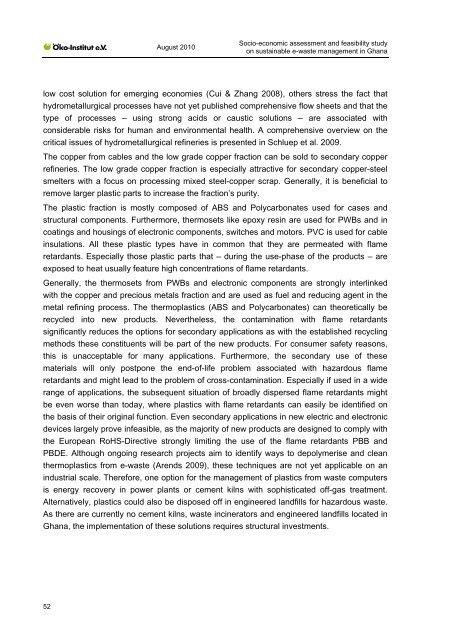Socio-economic assessment and feasibility study on - Öko-Institut eV
Socio-economic assessment and feasibility study on - Öko-Institut eV
Socio-economic assessment and feasibility study on - Öko-Institut eV
You also want an ePaper? Increase the reach of your titles
YUMPU automatically turns print PDFs into web optimized ePapers that Google loves.
52<br />
August 2010<br />
<str<strong>on</strong>g>Socio</str<strong>on</strong>g>-<str<strong>on</strong>g>ec<strong>on</strong>omic</str<strong>on</strong>g> <str<strong>on</strong>g>assessment</str<strong>on</strong>g> <str<strong>on</strong>g>and</str<strong>on</strong>g> <str<strong>on</strong>g>feasibility</str<strong>on</strong>g> <str<strong>on</strong>g>study</str<strong>on</strong>g><br />
<strong>on</strong> sustainable e-waste management in Ghana<br />
low cost soluti<strong>on</strong> for emerging ec<strong>on</strong>omies (Cui & Zhang 2008), others stress the fact that<br />
hydrometallurgical processes have not yet published comprehensive flow sheets <str<strong>on</strong>g>and</str<strong>on</strong>g> that the<br />
type of processes – using str<strong>on</strong>g acids or caustic soluti<strong>on</strong>s – are associated with<br />
c<strong>on</strong>siderable risks for human <str<strong>on</strong>g>and</str<strong>on</strong>g> envir<strong>on</strong>mental health. A comprehensive overview <strong>on</strong> the<br />
critical issues of hydrometallurgical refineries is presented in Schluep et al. 2009.<br />
The copper from cables <str<strong>on</strong>g>and</str<strong>on</strong>g> the low grade copper fracti<strong>on</strong> can be sold to sec<strong>on</strong>dary copper<br />
refineries. The low grade copper fracti<strong>on</strong> is especially attractive for sec<strong>on</strong>dary copper-steel<br />
smelters with a focus <strong>on</strong> processing mixed steel-copper scrap. Generally, it is beneficial to<br />
remove larger plastic parts to increase the fracti<strong>on</strong>’s purity.<br />
The plastic fracti<strong>on</strong> is mostly composed of ABS <str<strong>on</strong>g>and</str<strong>on</strong>g> Polycarb<strong>on</strong>ates used for cases <str<strong>on</strong>g>and</str<strong>on</strong>g><br />
structural comp<strong>on</strong>ents. Furthermore, thermosets like epoxy resin are used for PWBs <str<strong>on</strong>g>and</str<strong>on</strong>g> in<br />
coatings <str<strong>on</strong>g>and</str<strong>on</strong>g> housings of electr<strong>on</strong>ic comp<strong>on</strong>ents, switches <str<strong>on</strong>g>and</str<strong>on</strong>g> motors. PVC is used for cable<br />
insulati<strong>on</strong>s. All these plastic types have in comm<strong>on</strong> that they are permeated with flame<br />
retardants. Especially those plastic parts that – during the use-phase of the products – are<br />
exposed to heat usually feature high c<strong>on</strong>centrati<strong>on</strong>s of flame retardants.<br />
Generally, the thermosets from PWBs <str<strong>on</strong>g>and</str<strong>on</strong>g> electr<strong>on</strong>ic comp<strong>on</strong>ents are str<strong>on</strong>gly interlinked<br />
with the copper <str<strong>on</strong>g>and</str<strong>on</strong>g> precious metals fracti<strong>on</strong> <str<strong>on</strong>g>and</str<strong>on</strong>g> are used as fuel <str<strong>on</strong>g>and</str<strong>on</strong>g> reducing agent in the<br />
metal refining process. The thermoplastics (ABS <str<strong>on</strong>g>and</str<strong>on</strong>g> Polycarb<strong>on</strong>ates) can theoretically be<br />
recycled into new products. Nevertheless, the c<strong>on</strong>taminati<strong>on</strong> with flame retardants<br />
significantly reduces the opti<strong>on</strong>s for sec<strong>on</strong>dary applicati<strong>on</strong>s as with the established recycling<br />
methods these c<strong>on</strong>stituents will be part of the new products. For c<strong>on</strong>sumer safety reas<strong>on</strong>s,<br />
this is unacceptable for many applicati<strong>on</strong>s. Furthermore, the sec<strong>on</strong>dary use of these<br />
materials will <strong>on</strong>ly postp<strong>on</strong>e the end-of-life problem associated with hazardous flame<br />
retardants <str<strong>on</strong>g>and</str<strong>on</strong>g> might lead to the problem of cross-c<strong>on</strong>taminati<strong>on</strong>. Especially if used in a wide<br />
range of applicati<strong>on</strong>s, the subsequent situati<strong>on</strong> of broadly dispersed flame retardants might<br />
be even worse than today, where plastics with flame retardants can easily be identified <strong>on</strong><br />
the basis of their original functi<strong>on</strong>. Even sec<strong>on</strong>dary applicati<strong>on</strong>s in new electric <str<strong>on</strong>g>and</str<strong>on</strong>g> electr<strong>on</strong>ic<br />
devices largely prove infeasible, as the majority of new products are designed to comply with<br />
the European RoHS-Directive str<strong>on</strong>gly limiting the use of the flame retardants PBB <str<strong>on</strong>g>and</str<strong>on</strong>g><br />
PBDE. Although <strong>on</strong>going research projects aim to identify ways to depolymerise <str<strong>on</strong>g>and</str<strong>on</strong>g> clean<br />
thermoplastics from e-waste (Arends 2009), these techniques are not yet applicable <strong>on</strong> an<br />
industrial scale. Therefore, <strong>on</strong>e opti<strong>on</strong> for the management of plastics from waste computers<br />
is energy recovery in power plants or cement kilns with sophisticated off-gas treatment.<br />
Alternatively, plastics could also be disposed off in engineered l<str<strong>on</strong>g>and</str<strong>on</strong>g>fills for hazardous waste.<br />
As there are currently no cement kilns, waste incinerators <str<strong>on</strong>g>and</str<strong>on</strong>g> engineered l<str<strong>on</strong>g>and</str<strong>on</strong>g>fills located in<br />
Ghana, the implementati<strong>on</strong> of these soluti<strong>on</strong>s requires structural investments.

















